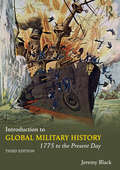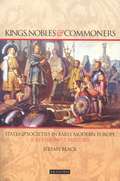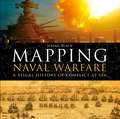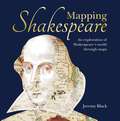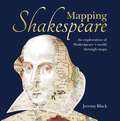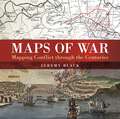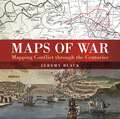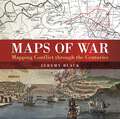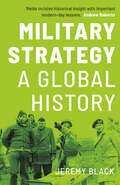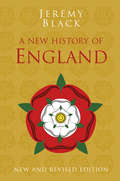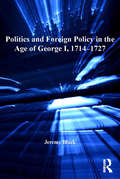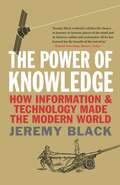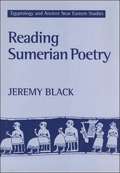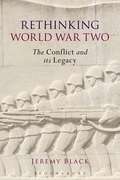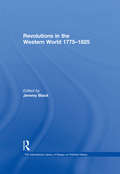- Table View
- List View
Introduction to Global Military History: 1775 to the Present Day
by Jeremy BlackThis lucid account of military developments around the modern world begins with the American War of Independence and the French revolutionary wars and continues chronologically to the latest 21st century conflicts. It combines determinedly global coverage with thought-provoking analysis not only of the military aspects of conflict but also its social, cultural, political and economic dimensions and consequences. By placing familiar events alongside the largely unknown, the reader is forced to reassess the standard grand narrative of military history that rests on assumptions of Western cultural and technological superiority. It will be essential reading for students worldwide, whether studying modern military history, modern world history, history and international relations or war and society. This fully updated second edition includes: chapter introductions and conclusions to assist study and revision 'Voices of War' sourced extracts from the field of conflict case studies in each chapter to support the narrative and provoke discussion a 12-page colour map section and over 20 other integrated maps annotated references from the latest publications in the field
Introduction to Global Military History: 1775 to the Present Day
by Jeremy BlackThis lucid account of military developments around the modern world begins with the American War of Independence and the French revolutionary wars and continues chronologically to the latest 21st century conflicts. It combines determinedly global coverage with thought-provoking analysis not only of the military aspects of conflict but also its social, cultural, political and economic dimensions and consequences. By placing familiar events alongside the largely unknown, the reader is forced to reassess the standard grand narrative of military history that rests on assumptions of Western cultural and technological superiority. It will be essential reading for students worldwide, whether studying modern military history, modern world history, history and international relations or war and society. This fully updated second edition includes: chapter introductions and conclusions to assist study and revision 'Voices of War' sourced extracts from the field of conflict case studies in each chapter to support the narrative and provoke discussion a 12-page colour map section and over 20 other integrated maps annotated references from the latest publications in the field
Introduction to Global Military History: 1775 to the Present Day
by Jeremy BlackIntroduction to Global Military History provides a lucid and comprehensive account of military developments around the modern world from the eighteenth century up to the present day. Beginning with the background to the American War of Independence and the French Revolutionary wars and ending with the recent conflicts of the twenty-first century, this third edition combines fully up-to-date global coverage with close analysis not only of the military aspects of war but also its social, cultural, political and economic dimensions and repercussions. The new edition includes a fully revised chapter on conflicts during the eighteenth century, updated coverage of events post-1990 and increased coverage of non-Western conflicts to provide a truly international account of the varied and changing nature of modern military history. Covering lesser-known conflicts as well as the familiar wars of history and illustrated throughout with maps, primary source extracts and case studies, it is essential reading for all students of modern military history and international relations.
Introduction to Global Military History: 1775 to the Present Day
by Jeremy BlackIntroduction to Global Military History provides a lucid and comprehensive account of military developments around the modern world from the eighteenth century up to the present day. Beginning with the background to the American War of Independence and the French Revolutionary wars and ending with the recent conflicts of the twenty-first century, this third edition combines fully up-to-date global coverage with close analysis not only of the military aspects of war but also its social, cultural, political and economic dimensions and repercussions. The new edition includes a fully revised chapter on conflicts during the eighteenth century, updated coverage of events post-1990 and increased coverage of non-Western conflicts to provide a truly international account of the varied and changing nature of modern military history. Covering lesser-known conflicts as well as the familiar wars of history and illustrated throughout with maps, primary source extracts and case studies, it is essential reading for all students of modern military history and international relations.
Kings, Nobles and Commoners: States and Societies in Early Modern Europe
by Jeremy BlackWas Protestantism `better' than Catholicism, contributing to well organised societies and economic enterprise? Or was Catholicism the religion of reactionary and backward states and societies like Spain and Austria, in contrast to the thrusting and modern bourgeois states of the United Netherlands and England? Certainly Spain and Austria declined but France, although Catholic and absolutist, rose to greatness, although the argument might be sustained by Britain's global triumph in the 18th century.Closely linked is the rise of the modern state in Europe and Russia - increasingly `European' under Peter the Great - and the Ottoman Empire. What was the structure of the modern state? Did rulers with administrative sophistication and centralisaton, buttresssed by a growing cadre of middle class civil servants - the `noblesse du robe' - and military and naval power, exercise absolute power over state and society? Or was royal absolutism a `myth', grand in display but bankrupt, increasingly opposed by all parts of society, and to swept away in revolution?Jeremy Black, one of the most prolific and stimulating scholars of early modern Europe sets his history in the context of the Middle East, Central, South and East and Asia and the New World, shows how Europe fits into a world view, and demonstrates that with the exception of Peter the Great's Russia, royal power in early modern Europe was based on compromise and traditional relationships with the aristocracy and gentry, the Estates, corporations, the church and with an element of common consent. Commercial progress was widespread, boundaries were stabilised, and European financial, technical and mineral resources fuelled New World expansion - until the revolutionary deluge after 1789.
Mapping Naval Warfare: A visual history of conflict at sea
by Jeremy BlackNaval operations and warfare were, and remain, a key element for mapping. Maps were vital for commanders in drawing up plans of attack, and their detail and usefulness have increased over the centuries as the science of mapping has developed.This beautiful book examines stunning original maps from a series of key conflicts from the Spanish Armada, the American Wars of Independence, and the Napoleonic wars to twentieth century conflicts from the First World War to Vietnam, and explains how they were represented through mapping and how the maps produced helped naval commanders to plan their strategy.
Mapping Naval Warfare: A visual history of conflict at sea
by Jeremy BlackNaval operations and warfare were, and remain, a key element for mapping. Maps were vital for commanders in drawing up plans of attack, and their detail and usefulness have increased over the centuries as the science of mapping has developed.This beautiful book examines stunning original maps from a series of key conflicts from the Spanish Armada, the American Wars of Independence, and the Napoleonic wars to twentieth century conflicts from the First World War to Vietnam, and explains how they were represented through mapping and how the maps produced helped naval commanders to plan their strategy.
Mapping Shakespeare: An exploration of Shakespeare’s worlds through maps
by Jeremy BlackWilliam Shakespeare's lifetime (1564–1616) spanned the reigns of the last of the Tudors, Elizabeth I and the first of the Stuart kings, James I and the changing times and political mores of the time were reflected through his plays. This beautiful new book looks at the England in which Shakespeare worked through maps and illustrations that reveal the way that he and his contemporaries saw their land and their place in the world. It also explores the locations of his plays and looks at the possible inspirations for these and why Shakespeare would have chosen to set his stories there.
Mapping Shakespeare: An exploration of Shakespeare’s worlds through maps
by Jeremy BlackWilliam Shakespeare's lifetime (1564–1616) spanned the reigns of the last of the Tudors, Elizabeth I and the first of the Stuart kings, James I and the changing times and political mores of the time were reflected through his plays. This beautiful new book looks at the England in which Shakespeare worked through maps and illustrations that reveal the way that he and his contemporaries saw their land and their place in the world. It also explores the locations of his plays and looks at the possible inspirations for these and why Shakespeare would have chosen to set his stories there.
Maps of War: Mapping Conflict Through the Centuries
by Jeremy BlackThere is little documented mapping of conflict prior to the Renaissance period, but, from the 17th century onwards, military commanders and strategists began to document the wars in which they were involved and later, to use mapping to actually plan the progress of a conflict. Using contemporary maps, this sumptuous new volume covers the history of the mapping of war on land and shows the way in which maps provide a guide to the history of war. Content includes:The beginnings of military mapping up to 1600 including the impact of printing and the introduction of gunpowderThe seventeenth century: The focus is on maps to illustrate war, rather than as a planning tool and the chapter considers the particular significance of maps of fortifications.The eighteenth century: The growing need for maps on a world scale reflects the spread of European power and of transoceanic conflict between Europeans. This chapter focuses in particular on the American War of Independence.The nineteenth century: Key developments included contouring and the creation of military surveying. Subjects include the Napoleonic Wars and the American Civil WarThe twentieth century including extended features on the First and Second World Wars including maps showing trench warfare and aerial reconnaissance. Much of the chapter focuses on the period from 1945 to the present day including special sections on the Vietnam War and the Gulf Wars.
Maps of War: Mapping Conflict Through the Centuries
by Jeremy BlackThere is little documented mapping of conflict prior to the Renaissance period, but, from the 17th century onwards, military commanders and strategists began to document the wars in which they were involved and later, to use mapping to actually plan the progress of a conflict. Using contemporary maps, this sumptuous new volume covers the history of the mapping of war on land and shows the way in which maps provide a guide to the history of war. Content includes:The beginnings of military mapping up to 1600 including the impact of printing and the introduction of gunpowderThe seventeenth century: The focus is on maps to illustrate war, rather than as a planning tool and the chapter considers the particular significance of maps of fortifications.The eighteenth century: The growing need for maps on a world scale reflects the spread of European power and of transoceanic conflict between Europeans. This chapter focuses in particular on the American War of Independence.The nineteenth century: Key developments included contouring and the creation of military surveying. Subjects include the Napoleonic Wars and the American Civil WarThe twentieth century including extended features on the First and Second World Wars including maps showing trench warfare and aerial reconnaissance. Much of the chapter focuses on the period from 1945 to the present day including special sections on the Vietnam War and the Gulf Wars.
Maps of War: Mapping Conflict Through the Centuries
by Jeremy BlackThere is little documented mapping of conflict prior to the Renaissance period, but, from the 17th century onwards, military commanders and strategists began to document the wars in which they were involved and later, to use mapping to actually plan the progress of a conflict. Using contemporary maps, this sumptuous new volume covers the history of the mapping of war on land and shows the way in which maps provide a guide to the history of war. Content includes:The beginnings of military mapping up to 1600 including the impact of printing and the introduction of gunpowderThe seventeenth century: The focus is on maps to illustrate war, rather than as a planning tool and the chapter considers the particular significance of maps of fortifications.The eighteenth century: The growing need for maps on a world scale reflects the spread of European power and of transoceanic conflict between Europeans. This chapter focuses in particular on the American War of Independence.The nineteenth century: Key developments included contouring and the creation of military surveying. Subjects include the Napoleonic Wars and the American Civil WarThe twentieth century including extended features on the First and Second World Wars including maps showing trench warfare and aerial reconnaissance. Much of the chapter focuses on the period from 1945 to the present day including special sections on the Vietnam War and the Gulf Wars.
Maps of War: Mapping Conflict Through the Centuries
by Jeremy BlackThere is little documented mapping of conflict prior to the Renaissance period, but, from the 17th century onwards, military commanders and strategists began to document the wars in which they were involved and later, to use mapping to actually plan the progress of a conflict. Using contemporary maps, this sumptuous new volume covers the history of the mapping of war on land and shows the way in which maps provide a guide to the history of war. Content includes:The beginnings of military mapping up to 1600 including the impact of printing and the introduction of gunpowderThe seventeenth century: The focus is on maps to illustrate war, rather than as a planning tool and the chapter considers the particular significance of maps of fortifications.The eighteenth century: The growing need for maps on a world scale reflects the spread of European power and of transoceanic conflict between Europeans. This chapter focuses in particular on the American War of Independence.The nineteenth century: Key developments included contouring and the creation of military surveying. Subjects include the Napoleonic Wars and the American Civil WarThe twentieth century including extended features on the First and Second World Wars including maps showing trench warfare and aerial reconnaissance. Much of the chapter focuses on the period from 1945 to the present day including special sections on the Vietnam War and the Gulf Wars.
A Military Revolution?: Military Change and European Society 1550–1800 (Studies in European History)
by Jeremy BlackIn this radical reassessment, Jeremy Black challenges many of the established assumptions about the so-called Military Revolution of 1560- 1660. He argues that it is far from clear that a military revolution did occur during this period. Indeed there is more evidence to suggest that the description could be applied more accurately to the following hundred years. This book also re-examines the relationship between military strength and domestic stability. Rather than seeing the latter as the consequence of the former, Dr Black argues that it makes more sense to see the former as a result of the latter.
Military Strategy: A Global History
by Jeremy BlackA global account of military strategy, which examines the practices, rather than the theories, of the most significant military figures of the past 400 years Strategy has existed as long as there has been organised conflict. In this new account, Jeremy Black explores the ever-changing relationship between purpose, force, implementation and effectiveness in military strategy and its dramatic impact on the development of the global power system. Taking a ‘total’ view of strategy, Black looks at leading powers — notably the United States, China, Britain and Russia — in the wider context of their competition and their domestic and international strengths. Ranging from France’s Ancien Regime and Britain’s empire building to present day conflicts in the Middle East, Black devotes particular attention to the strategic practice and decisions of the Kangxi Emperor, Clausewitz, Napoleon and Hitler.
Naval Power: A History of Warfare and the Sea from 1500 onwards
by Jeremy BlackMan lives on land, but the seas of the world are crucial to his lot. Focusing on navies as instruments of power and analysing what they indicate about the nature of state systems and cultures all over the world, Black provides an overview of the most significant debates within the field. Organised into key historical periods and accessibly framed, this wide-ranging account emphasises the links between past and present throughout the history of naval power.
A New History of England (Classic Histories Series)
by Jeremy BlackIn this new and updated edition of A New History of England, historian Jeremy Black takes a cool and dispassionate look at the vicissitudes of over two millennia of English history. He identifies two central themes: the lack of geographical and economic uniformity within England; and the fact that, from the Roman invasion onwards, a united England was often politically associated with part of Europe, from the Scandinavian Cnut to the German origins of the Hanoverians and their descendants. Professor Black steers his way through the labyrinthine complexities of historical narrative with elegance and clarity, providing a lively analysis of major events and personalities and important underlying themes, taking his account right up to the Brexit controversy.
Politics and Foreign Policy in the Age of George I, 1714-1727
by Jeremy BlackThrough its focus on the relationship between foreign and domestic politics, this book provides a new perspective on the often fractious and tangled events of George I’s reign (1714-27). This was a period of transition for Britain, as royal authority gave way to cabinet government, and as the country began to exercise increased influence upon the world stage. It was a reign that witnessed the trauma of the 1715 Jacobite Rebellion, saw Britain fighting Spain as part of the Quadruple Alliance, and in which Britain confronted the rise of Russia under Peter the Great. There has been relatively little new detailed work on this subject since Hatton’s biography of George I appeared in 1978, and that book, while impressive, devoted relatively little attention to the domestic political dimension of foreign policy. In contrast, Black links diplomacy to domestic politics to show that foreign policy was a key aspect of government as well as the leading battleground both for domestic politics and for ministerial rivalries. As a result he demonstrates how party identities in foreign policy were not marginal, to either policy or party, but, instead, central to both. The research is based upon a wealth of both British and foreign archive material, including State Papers Domestic, Scotland, Ireland and Regencies, as well as Foreign. Extensive use is also made of parliamentary and ministerial papers, as well as the private papers of numerous diplomats. Foreign archives consulted include papers from Hanover, Osnabrück, Darmstadt, Marburg, Munich, Paris, The Hague, Vienna and Turin. By drawing upon such a wide ranging array of sources, this book offers a rich and nuanced view of politics and foreign policy under George I.
Politics and Foreign Policy in the Age of George I, 1714-1727
by Jeremy BlackThrough its focus on the relationship between foreign and domestic politics, this book provides a new perspective on the often fractious and tangled events of George I’s reign (1714-27). This was a period of transition for Britain, as royal authority gave way to cabinet government, and as the country began to exercise increased influence upon the world stage. It was a reign that witnessed the trauma of the 1715 Jacobite Rebellion, saw Britain fighting Spain as part of the Quadruple Alliance, and in which Britain confronted the rise of Russia under Peter the Great. There has been relatively little new detailed work on this subject since Hatton’s biography of George I appeared in 1978, and that book, while impressive, devoted relatively little attention to the domestic political dimension of foreign policy. In contrast, Black links diplomacy to domestic politics to show that foreign policy was a key aspect of government as well as the leading battleground both for domestic politics and for ministerial rivalries. As a result he demonstrates how party identities in foreign policy were not marginal, to either policy or party, but, instead, central to both. The research is based upon a wealth of both British and foreign archive material, including State Papers Domestic, Scotland, Ireland and Regencies, as well as Foreign. Extensive use is also made of parliamentary and ministerial papers, as well as the private papers of numerous diplomats. Foreign archives consulted include papers from Hanover, Osnabrück, Darmstadt, Marburg, Munich, Paris, The Hague, Vienna and Turin. By drawing upon such a wide ranging array of sources, this book offers a rich and nuanced view of politics and foreign policy under George I.
The Power of Knowledge: How Information and Technology Made the Modern World
by Jeremy BlackInformation is power. For more than five hundred years the success or failure of nations has been determined by a country’s ability to acquire knowledge and technical skill and transform them into strength and prosperity. Leading historian Jeremy Black approaches global history from a distinctive perspective, focusing on the relationship between information and society and demonstrating how the understanding and use of information have been the primary factors in the development and character of the modern age. Black suggests that the West’s ascension was a direct result of its institutions and social practices for acquiring, employing, and retaining information and the technology that was ultimately produced. His cogent and well-reasoned analysis looks at cartography and the hardware of communication, armaments and sea power, mercantilism and imperialism, science and astronomy, as well as bureaucracy and the management of information, linking the history of technology with the history of global power while providing important indicators for the future of our world.
Reading Sumerian Poetry (Athlone Publications in Egyptology & Ancient Near Eastern Studies)
by Jeremy BlackAn analysis of the oldest form of poetry. Sumer, in the southern part of Iraq, created the first literary culture in history, as early as 2500BC. The account is structured around a complete English translation of the fragmentary Lugalbanda poems, narrating the adventures of the eponymous hero. The study reveals a work of a rich and sophisticated poetic imagination and technique, which, far from being in any sense 'primitive', are so complex as to resist much modern literary analysis.
Rethinking World War Two: The Conflict and its Legacy
by Jeremy BlackHistory is both the past and our accounts of the past. In Rethinking World War Two, Jeremy Black explores the contesting accounts and interpretations of the war, critically examining the leading controversies surrounding the conflict, its aftermath and its ongoing significance in the modern world. The first half of the book considers controversies surrounding the course of the war, with chapters looking at the importance of military history, the causes of the war, politics and grand strategy and domestic politics. The second half goes on to consider the memory of the war and its echoes in political and military spheres, with chapters devoted to the memory of the war in Europe and in Asia. A detailed further reading section provides guidance on how to take study of various topics further. Rethinking World War Two is unique in offering a survey of both the events of the conflict and the various debates surrounding its memory. It will be an invaluable resource for any student of World War Two, particularly those seeking a better understanding of its continuing legacy in the postwar world.
Rethinking World War Two: The Conflict and its Legacy
by Jeremy BlackHistory is both the past and our accounts of the past. In Rethinking World War Two, Jeremy Black explores the contesting accounts and interpretations of the war, critically examining the leading controversies surrounding the conflict, its aftermath and its ongoing significance in the modern world. The first half of the book considers controversies surrounding the course of the war, with chapters looking at the importance of military history, the causes of the war, politics and grand strategy and domestic politics. The second half goes on to consider the memory of the war and its echoes in political and military spheres, with chapters devoted to the memory of the war in Europe and in Asia. A detailed further reading section provides guidance on how to take study of various topics further. Rethinking World War Two is unique in offering a survey of both the events of the conflict and the various debates surrounding its memory. It will be an invaluable resource for any student of World War Two, particularly those seeking a better understanding of its continuing legacy in the postwar world.
Revolutions in the Western World 1775–1825 (The International Library of Essays on Political History)
by Jeremy BlackConsidering what has been described as an Age of Revolutions, Black assesses a formative period in world history by examining the North American, European, Haitian and Latin American Revolutions. Causes, courses and consequences are all clarified in the articles selected and an introduction charts the major themes.
Revolutions in the Western World 1775–1825 (The International Library of Essays on Political History)
by Jeremy BlackConsidering what has been described as an Age of Revolutions, Black assesses a formative period in world history by examining the North American, European, Haitian and Latin American Revolutions. Causes, courses and consequences are all clarified in the articles selected and an introduction charts the major themes.

